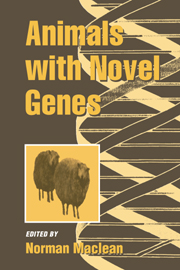3 - Transgenic fish
Published online by Cambridge University Press: 21 October 2009
Summary
The introduction of novel genes into fish of many species has become a common procedure. It has been reviewed by Ozato et al. (1989), Chourrout et al. (1990), Cloud (1990), Maclean and Penman (1990), Fletcher and Davies (1991), Guise et al. (1991), Houdebine and Chourrout (1991), Powers et al. (1992a) and Hew and Fletcher (1992). A comprehensive review would now be a major task. Instead we attempt a shorter appraisal of certain critical aspects of this research area.
Fish species selection
The species of fish which have been subjected to transgenic induction include Atlantic salmon (Salmo Salar; see, e.g., Shears et al. 1991), rainbow trout (Oncorhynchus mykiss; e.g., Guyomard et al. 1989), tilapia (Oreochromis niloticus; Brem et al. 1988; Rahman & Maclean 1992a), carp (Cyprinus carpio; Zhang et al. 1990), channel cat-fish (Ictalurus punctatus; Dunham et al. 1987), African cat-fish (Clarias gariepinus; Muller et al. 1992) and northern pike (Esox lucius; e.g., Guise et al. 1992), and attempts have been made with sea bass (Sparus auratus; Cavari et al. 1993). In addition to these commercially important species, certain “model” fish have been used, notably goldfish (Carassius auratus; see, e.g., Yoon et al. 1990), loach (Misgurnus fossilis; e.g., Kozlov et al. 1988), medaka (Oryzias latipes; e.g., Ozato et al. 1986) and zebra fish (Brachydanio rerio; e.g., Stuart et al. 1990).
Unless there are compelling local or strategic reasons for choosing salmonids or other slow-maturing species, it seems that small, fast-maturing species make better initial choices in the present stage of development of this field. Zebra fish and medaka make excellent models, especially the former species, for which a substantial genetic background exists.
- Type
- Chapter
- Information
- Animals with Novel Genes , pp. 63 - 105Publisher: Cambridge University PressPrint publication year: 1995
- 5
- Cited by



